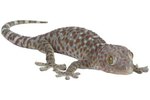
Tortoises are known for a few distinct features: their naturally long lifespans, their very slow movements and their large, half-dome shells. The shell is a signature asset for the tortoise, allowing the animal to retract its head and limbs inside to ward off predators. This remarkable creature has evolved in a few key ways to enable this defensive move.
Neck Muscles
The tortoise is classified as a vertebrate, meaning it's among the animals that have backbones. However, unlike most other vertebrates, tortoises have completely rigid spines inside their shells. This means that tortoises can't use their back muscles to move or contort their bodies. Instead, these animals rely on exceptionally strong neck muscles. Having unusually flexible necks allows the tortoise to retract its head into the shell. This capability compensates for the tortoise's inability to move muscles on its back and lower body.
Soft Skin
A distinct characteristic of any tortoise is its hard outer shell. The thick, tough exterior of the shell serves to protect the animals from predators. Although this part of the tortoise is very rigid and strong, the skin on the animal's limbs has a totally different texture. The neck, arms, legs and belly of the tortoise are covered in very soft, loose skin. This pliant texture lets the tortoise move its limbs, even as its shell remains rigid.
Shells aren't Solid
The tortoise's shell appears to be one solid surface, but it's actually made of separate pieces. The top half, or carapace, forms the half-dome shape of the shell. The bottom half, or plastron, covers the belly. The carapace and plastron are joined to each other by the bridge. Because the shell is not one stiff piece, the tortoise has the flexibility to move inside its shell. Somes tortoise can even draw the plastron shut after they've retracted their head and limbs.
Small Head and Limb Size
Compared to other vertebrates, the tortoise's head and limbs are relatively small for its body size. Varieties of tortoise can range in shell size from a few inches to nearly six feet. Still, no matter how large the shell grows, the head and limbs remain at a much smaller proportion to the shell. In fact, in some tortoises the head will be smaller than the arms. Because these appendages are small, the tortoise can make room to withdraw them inside its much larger shell.
References
Photo Credits
-
Thinkstock/Comstock/Getty Images
Writer Bio
Chloe Newkirk is a writer based in the San Francisco Bay Area. She has been a freelance writer for over five years, and written for a variety of publications. She is a graduate of St. Edward's University in Austin, Texas. Her areas of expertise include crafts, pop culture, the arts, pets, American history and food.




